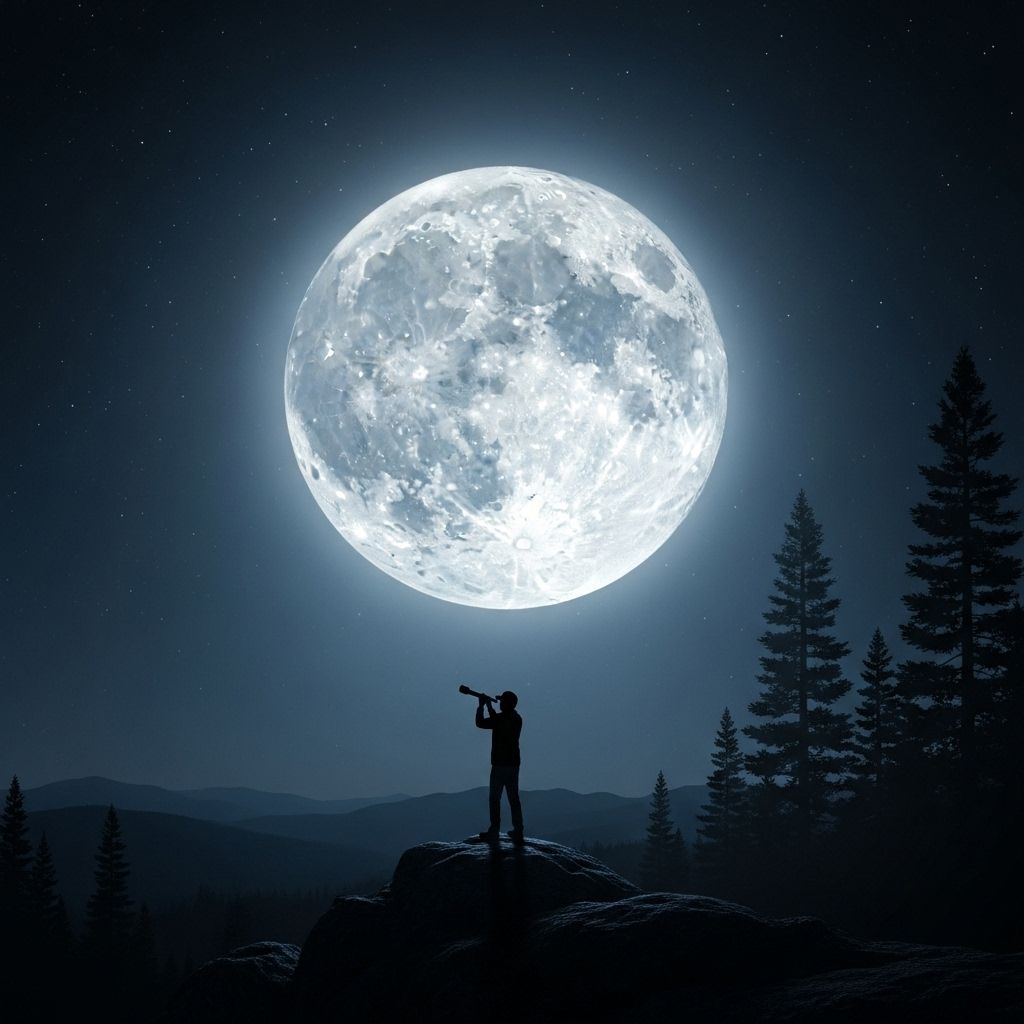Full Moon Dates 2025: 12 Names, Dates & Observing Tips
A comprehensive guide to every full moon in 2025, their traditional names, cultural origins, and fascinating lunar facts.

Image: HearthJunction Design Team
Full Moon Calendar 2025: Dates, Names, and Illuminating Facts
The moon’s monthly transformation from a slender crescent to a radiant disk and back again has captivated humanity for millennia. Each month, the full moon brightens the night sky, marked by traditions, stories, and astronomical wonders. In this comprehensive guide, you’ll discover the full moon dates for 2025, the unique names each one carries, the cultural stories behind these names, and practical observing tips for moonwatchers everywhere.
Full Moon Dates and Names for 2025
Below is the complete calendar of full moons for 2025, including the traditional names by which each is known in North America. The timing of each full moon may vary slightly depending on your time zone, but the following table uses Eastern Time (ET) for consistency.
| Month | Date & Time (ET) | Traditional Name | Notable Events |
|---|---|---|---|
| January | January 13, 5:22 p.m. | Wolf Moon | Occults Mars (visible in North America) |
| February | February 12, 10:23 a.m. | Snow Moon | – |
| March | March 14, 1:54 a.m. | Worm Moon | – |
| April | April 12, 11:23 p.m. | Pink Moon | – |
| May | May 12, 8:03 p.m. | Flower Moon | – |
| June | June 11, 7:45 a.m. | Strawberry Moon | Near star Antares |
| July | July 10, 4:57 p.m. | Buck Moon | – |
| August | August 9, 12:55 a.m. | Sturgeon Moon | – |
| September | September 7, 8:18 a.m. | Harvest Moon | – |
| October | October 6, 3:47 p.m. | Hunter’s Moon | – |
| November | November 5, 10:21 p.m. | Beaver Moon | – |
| December | December 5, 6:05 a.m. | Cold Moon | – |
While these names stem largely from Native American and Colonial folklore, they’re now widely used by skywatchers around the world to mark the lunar cycles.
The Origins and Meaning of Full Moon Names
Each full moon gets its name from seasonal signs in nature, agricultural rhythms, or cultural traditions. Here’s a breakdown of the origins for each:
- Wolf Moon (January): Named for the howling of wolves on winter nights, as recorded in Native American and colonial traditions.
- Snow Moon (February): Reflects the heavy snows falling in midwinter, making hunting difficult.
- Worm Moon (March): Marks the earliest signs of spring, when earthworms reappear with the thawing ground.
- Pink Moon (April): Named after the pink wildflower, phlox, which blossoms in early spring in eastern North America.
- Flower Moon (May): Celebrates the abundance of blooming flowers as spring reaches its peak.
- Strawberry Moon (June): Coincides with the short strawberry-picking season. In Europe, it’s sometimes called the Rose Moon.
- Buck Moon (July): Refers to the time when buck deer begin to grow new antlers.
- Sturgeon Moon (August): Named by indigenous fishing tribes for the large sturgeon fish that were most readily caught this month.
- Harvest Moon (September): The full moon nearest the autumnal equinox, helping farmers harvest their crops by moonlight.
- Hunter’s Moon (October): Traditionally marks the time to hunt and store provisions for winter.
- Beaver Moon (November): Named for beavers making their winter dams, or when trappers set beaver traps before waters froze.
- Cold Moon (December): Reflects the cold and long nights of early winter.
Understanding the Lunar Cycle: What Makes a Full Moon?
A full moon occurs when the moon is directly opposite the sun from Earth’s perspective, with the entire near side illuminated. Here’s how the lunar phases progress:
- New Moon: The moon is between Earth and the sun and is invisible to us.
- Waxing Crescent: A sliver of moon emerges, growing nightly.
- First Quarter: Half the moon’s disk is lit.
- Waxing Gibbous: More than half visible, but not yet full.
- Full Moon: The moon’s face is fully illuminated – the brightest lunar phase.
- Waning Gibbous: The illuminated portion shrinks each night.
- Last Quarter: Half the disk is visible, now shrinking.
- Waning Crescent: Just a thin sliver remains before the cycle begins anew.
Each phase results from the changing geometry between the moon, Earth, and sun as the moon orbits our planet.
Noteworthy Full Moons and Astronomical Highlights in 2025
Several full moons in 2025 will be especially interesting for skywatchers:
- January’s Wolf Moon: Will occult (pass in front of) Mars, an event visible from across the continental U.S., Mexico, Canada, and western Africa. Watch as Mars disappears and then reemerges from behind the moon!
- June’s Strawberry Moon: Appears near the bright red star Antares in the constellation Scorpius, making for a dramatic pairing in the night sky.
- The Harvest Moon in September: Rises soon after sunset for several nights in a row, creating long, moonlit evenings close to the autumn equinox.
Tips for Observing the Full Moon
- Choose a location: Find an open spot with a clear view of the horizon for moonrise or moonset. Urban rooftops, open fields, or lakeshores are ideal.
- Check moonrise and moonset times: Use astronomy apps or local weather websites to know exactly when the moon will rise in your area. The full moon often rises shortly after sunset.
- Use binoculars or a small telescope: While the full moon is visible to the naked eye, magnification reveals breathtaking detail in the lunar maria, bright rays, and cratered highlands.
- Photography: Moonrise and moonset offer the best opportunities for dramatic photos, especially when the moon is low above the horizon and foreground objects add interest.
- Beware the brightness: The full moon’s glare can obscure fainter stars. For deep-sky stargazing, plan around the new moon instead.
Why Do Full Moons Look So Big on the Horizon?
The famous “moon illusion” makes the full moon look unusually large when it’s close to the horizon. This is an optical effect caused by the way our brains interpret the moon’s size in relation to nearby objects like trees or buildings. Despite appearances, the moon’s angular size remains almost unchanged throughout the night.
Full Moon, Supermoon, and Blue Moon: What’s the Difference?
- Full Moon: The phase when the moon appears as a completely illuminated disk.
- Supermoon: A full moon that coincides with the moon’s closest approach to Earth (perigee), making it appear slightly larger and brighter.
- Blue Moon: Traditionally, the second full moon in a single calendar month. Blue moons occur roughly every 2-3 years.
Lunar Lore and Cultural Significance
For centuries, full moons have been entwined with folklore, agriculture, and religious observances. Farmers used full moons to guide planting and harvesting. Indigenous peoples named each full moon according to weather, animal behavior, or natural phenomena. In modern times, full moons inspire festivals, moon-gazing gatherings, and a sense of cosmic connection across cultures.
Frequently Asked Questions (FAQs)
When is the next full moon in 2025?
The next full moon after today’s date (June 12, 2025) is the Buck Moon on July 10, 2025 at 4:57 p.m. ET.
Why do the dates of the full moon vary each month?
The moon takes about 29.5 days to complete a lunation, but because our months are not exactly in sync with the lunar cycle, the dates shift month to month.
Do both hemispheres see the same full moon names?
While the moon’s phase is the same worldwide, the names reflect Northern Hemisphere seasons and traditions; Southern Hemisphere cultures often have their own naming systems.
Can I see features on the moon with my eyes?
Yes! Even without binoculars or a telescope, you can spot the dark maria (seas) and bright highlands. Craters are visible along the edge, especially during other phases.
Does the full moon affect human behavior?
Despite long-standing beliefs, scientific studies show little evidence that the full moon has a significant impact on human mood or behavior.
Conclusion: Celebrate the Full Moon Cycle
Whether you’re a dedicated astronomer, a nature lover, or simply a fan of cosmic beauty, the full moon offers a reminder of our connection to the rhythms of space and time. Mark these dates in your calendar, share in cultural traditions, and make time to look up—the moon’s timeless splendor awaits, month after month.
References
Read full bio of medha deb











